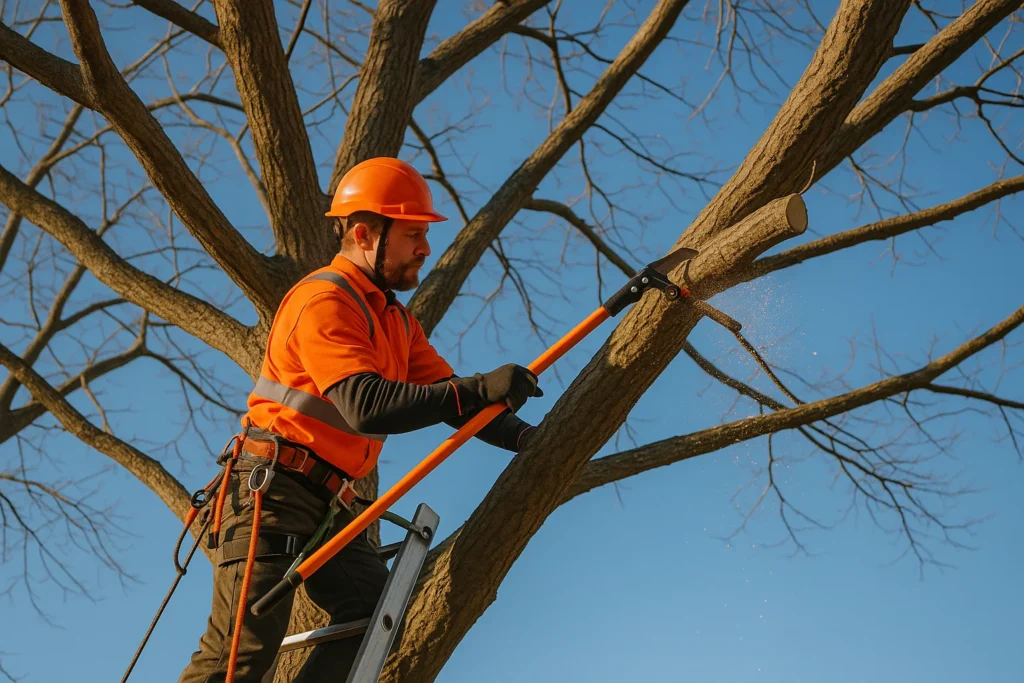The best time to trim trees is during late winter to early spring (February through March) when trees remain dormant before new growth begins. At American Outdoor, we recommend this dormant season because trees experience minimal stress, wounds heal faster, and disease transmission risks decrease significantly. However, timing varies by tree species, climate zone, and your specific trimming objectives. Dead or damaged branches require immediate removal regardless of season for safety reasons. Light pruning and shaping can occur during summer, while fall trimming should be avoided as it stimulates new growth that won’t survive winter temperatures. Understanding seasonal trimming guidelines protects your trees’ health and enhances their natural beauty throughout the year.
Understanding Tree Trimming Timing
Tree trimming isn’t just about cutting branches—it’s a strategic practice that requires perfect timing. When you trim at the right moment, your trees respond with vigorous growth, improved structure, and enhanced disease resistance. Poor timing weakens trees, invites pests, and can even cause permanent damage.
American Outdoor has developed comprehensive timing strategies based on decades of arboricultural experience. We’ve learned that nature provides clear signals indicating optimal trimming windows for different tree species and situations.
The Best Season for Tree Trimming
Late Winter: The Prime Trimming Window (January-March)
Late winter offers the absolute best conditions for major tree trimming projects. Trees stand dormant, having stored energy in their root systems throughout fall and early winter. When you trim during this period, you set the stage for explosive spring growth.
Benefits of Late Winter Trimming:
- Trees experience minimal stress and bleeding
- Wounds close quickly when spring growth begins
- Disease-causing organisms remain inactive in cold temperatures
- Clear visibility of tree structure without foliage
- Insects and pests stay dormant
- Trees direct energy toward healing and new growth
American Outdoor schedules most major trimming projects between February and early March, just before buds begin swelling. This timing gives trees maximum recovery advantage.
Early Spring: Strategic Light Trimming (March-April)
Early spring works well for light corrective pruning and shaping. As buds start swelling but before leaves fully emerge, you can still see tree structure clearly while taking advantage of accelerated healing.
Avoid heavy pruning during this period because trees actively move nutrients upward to support new growth. Major cuts disrupt this critical process.
Summer: Targeted Maintenance Trimming (June-August)
Summer trimming serves specific purposes rather than major structural work. This season allows you to:
- Remove dead or diseased branches immediately
- Control excessive growth in young trees
- Correct storm damage promptly
- Shape hedges and ornamental trees
- Improve visibility near roads or buildings
Summer wounds heal quickly, but trees may respond with excessive regrowth requiring additional maintenance.
Fall: The Season to Avoid (September-November)
Never conduct major tree trimming in fall. This season creates multiple problems:
- Fresh cuts stimulate new growth that winter will kill
- Trees prepare for dormancy instead of healing wounds
- Fungi and diseases spread most actively
- Trees lack energy reserves for proper healing
- Decay-causing organisms remain highly active
Emergency removal of hazardous branches remains necessary regardless of season, but planned trimming should avoid fall completely.
Seasonal Tree Trimming Calendar
| Season | Trimming Activity | Tree Response | Best For |
|---|---|---|---|
| Late Winter (Jan-Mar) | Major structural pruning | Rapid spring healing, vigorous growth | Deciduous trees, fruit trees, major shaping |
| Early Spring (Mar-Apr) | Light corrective pruning | Active growth phase begins | Minor adjustments, dead branch removal |
| Summer (Jun-Aug) | Maintenance trimming | Quick wound closure | Storm damage, visibility clearing, light shaping |
| Fall (Sep-Nov) | Avoid all major trimming | Preparing for dormancy | Emergency hazard removal only |
| Early Winter (Dec) | Begin dormant season work | Fully dormant state | Cold-hardy species, initial assessment |
Species-Specific Trimming Guidelines
Different tree species require unique timing considerations:
Deciduous Trees: Trim during late winter dormancy. Maples, birches, and walnuts “bleed” sap heavily if trimmed in early spring, though this doesn’t harm the tree—it just looks alarming.
Evergreen Trees: Trim in late winter or early summer after new growth hardens. Avoid trimming in fall when evergreens can’t seal wounds before winter.
Flowering Trees: Timing depends on bloom schedule. Spring-blooming trees (flowering in early spring on last year’s growth) should be trimmed immediately after flowering. Summer-blooming trees benefit from late winter trimming.
Fruit Trees: Trim during late dormant season (February-March) to maximize fruit production and maintain manageable size. This timing stimulates productive growth while minimizing disease exposure.
Signs Your Trees Need Trimming
Watch for these indicators regardless of season:
Immediate Safety Hazards:
- Dead or dying branches hanging over structures or walkways
- Broken branches from storms or wind damage
- Branches touching power lines or utility cables
- Limbs blocking street signs or traffic visibility
- Heavy branches showing crack or split signs
Structural Issues:
- Crossed or rubbing branches damaging each other
- Codominant stems creating weak attachment points
- Excessive weight on one side causing imbalance
- Dense canopy preventing light and air circulation
- Low-hanging branches obstructing pathways
Health Concerns:
- Diseased branches showing discoloration or fungal growth
- Pest-infested areas requiring removal
- Dead wood attracting wood-boring insects
- Declining foliage in specific branch sections
American Outdoor recommends professional assessment when you notice any of these warning signs.
Pro Tip: The “One-Third Rule” for Optimal Results
Pro Tip: Never remove more than one-third of a tree’s total canopy in a single trimming session, regardless of season. This principle, followed religiously by American Outdoor professionals, prevents shock and maintains the tree’s ability to produce enough energy through photosynthesis. If your tree requires extensive work, plan multiple trimming sessions spread across 2-3 years. Trees that lose more than one-third of their canopy experience severe stress, become vulnerable to disease, and may never fully recover. When in doubt, trim less—you can always remove more growth during the next season, but you cannot undo excessive pruning. This conservative approach ensures long-term tree health and vitality.
Climate and Regional Timing Considerations
Your geographic location significantly impacts optimal trimming schedules:
Northern Climates (Zones 3-5): Trim in late February through early March. Ensure completion before buds break in April. Later frost dates require more conservative timing.
Temperate Regions (Zones 6-7): Trim from mid-January through mid-March. Longer growing seasons provide more flexibility but require earlier dormant-season work.
Southern Climates (Zones 8-10): Trim in December through February. Shorter dormancy periods and earlier spring growth require adjusted scheduling.
Coastal Areas: Monitor local microclimates. Salt exposure and wind patterns influence ideal trimming windows. Generally follow regional zone guidelines with monthly adjustments.
Weather Conditions and Daily Timing
Beyond seasonal considerations, specific weather conditions affect trimming success:
Ideal Conditions:
- Dry weather with temperatures above freezing
- Calm winds for safety and precision
- Overcast days preventing sun scald on fresh wounds
- Moderate humidity levels
Conditions to Avoid:
- Freezing temperatures causing brittle wood
- Rainy or wet conditions spreading diseases
- Extreme heat stressing trees further
- High winds creating dangerous working conditions
Equipment and Technique Considerations
| Trimming Tool | Best For | Proper Use Timing |
|---|---|---|
| Hand Pruners | Branches under 3/4 inch diameter | Any appropriate season |
| Loppers | Branches 3/4 to 1.5 inches | Dormant season preferred |
| Pruning Saw | Branches 1.5 to 3 inches | Late winter for major cuts |
| Pole Pruner | High branches up to 12 feet | Summer for light maintenance |
| Chainsaw | Large branches over 3 inches | Professional use, dormant season |
American Outdoor uses professional-grade equipment maintained to exact specifications, ensuring clean cuts that promote rapid healing.
Common Trimming Mistakes to Avoid
Topping Trees: Never cut the main trunk or leader. This devastating practice creates weak regrowth, invites disease, and ruins tree structure permanently.
Flush Cutting: Avoid cutting branches completely flush with the trunk. Leave the branch collar intact—this swollen area contains specialized cells that seal wounds naturally.
Lion’s Tailing: Don’t strip all interior branches leaving only foliage at branch ends. This creates weak, wind-vulnerable growth and stresses trees.
Over-Trimming: Excessive pruning shocks trees and depletes energy reserves needed for recovery and growth.
Final Thoughts
Understanding when to trim trees transforms this essential maintenance task from guesswork into science-backed practice. Late winter remains the optimal window for most tree species, offering maximum health benefits and minimal stress during the dormant period.
American Outdoor combines seasonal timing expertise with species-specific knowledge to deliver trimming services that enhance tree health, safety, and aesthetic appeal. We recognize that every tree, property, and situation presents unique considerations requiring professional assessment.
Don’t risk tree health with improper timing or techniques. Schedule your professional tree trimming assessment today and let American Outdoor’s certified arborists develop a customized maintenance plan that keeps your trees healthy, beautiful, and safe throughout every season.
Frequently Asked Questions
When to trim a bay tree?
Trim bay trees in late spring (May-June) after frost danger passes and before summer heat arrives. Bay trees respond best to light, frequent trimming throughout the growing season rather than heavy annual pruning. Remove dead or damaged branches any time you notice them. Bay trees tolerate trimming well and benefit from regular shaping to maintain compact, bushy growth. American Outdoor recommends trimming bay trees twice yearly—once in late spring for major shaping and again in late summer for maintenance.
When to trim an olive tree?
Trim olive trees in late winter to early spring (February-March) during their dormant period. This timing allows olive trees to heal before producing new growth. Avoid trimming during active growing season or when fruit develops. Remove dead wood, crossed branches, and water sprouts during the dormant window. Mature olive trees require minimal pruning—focus on maintaining open canopy structure for light penetration and air circulation. American Outdoor spaces major olive tree trimming 2-3 years apart.
When to trim bay tree?
The optimal time to trim bay trees is late spring through early summer (May-June) when frost risk disappears. Bay trees tolerate regular light trimming throughout the growing season, making them excellent for topiary and formal hedges. Avoid heavy pruning in fall or winter when growth slows. Shape bay trees multiple times during summer to maintain desired form. Remove any frost-damaged growth in early spring before new growth emerges. American Outdoor trims ornamental bay trees every 6-8 weeks during the growing season.
When to trim cherry trees?
Trim cherry trees in late summer (July-August) after harvest completion. This timing minimizes silver leaf disease and bacterial canker risks that peak during winter and spring. Never trim cherry trees during dormancy—this increases infection vulnerability significantly. Summer trimming allows wounds to heal before winter while disease organisms remain less active. Remove dead, diseased, or damaged wood immediately regardless of season. American Outdoor schedules cherry tree trimming exclusively during late summer for optimal health protection.
When to trim holly trees?
Trim holly trees in late winter to early spring (February-March) before new growth begins. Holly trees tolerate heavy pruning during dormancy without stress. Alternatively, trim holly lightly in early summer (June) after spring growth hardens. Avoid fall trimming because new growth won’t mature before winter. Remove dead or damaged holly branches any time throughout the year. For formal holly hedges, American Outdoor recommends light trimming in spring and again in mid-summer to maintain precise shapes. Holly responds well to both timing approaches depending on your landscaping goals.

